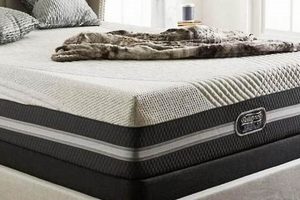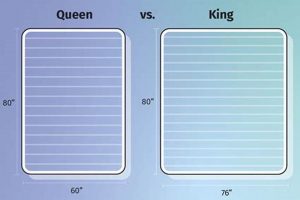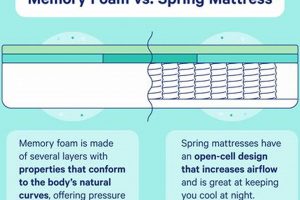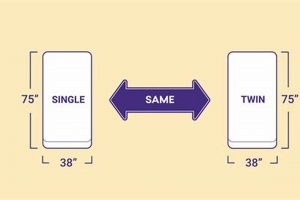The spectrum of mattress firmness offers varying levels of support and conformability. On one end lies a surface characterized by minimal give, providing a rigid and stable feel. Conversely, a surface with slightly more cushioning allows for a degree of sinkage, distributing weight across a broader area. This subtle distinction in construction impacts spinal alignment, pressure point relief, and overall sleep experience.
Selecting an appropriate sleep surface is a crucial decision influencing long-term health and well-being. The level of support affects posture and can mitigate or exacerbate existing back pain. Furthermore, the surface’s ability to contour to the body’s natural curves can minimize pressure on sensitive areas such as shoulders and hips, promoting restful sleep and reducing tossing and turning throughout the night. Understanding these fundamental differences is paramount in choosing a product that caters to individual needs and preferences.
Therefore, exploring the nuanced differences in construction materials, manufacturing processes, and resulting feel is essential. Understanding these factors will allow individuals to make informed decisions based on their specific sleep styles, body types, and pre-existing conditions, leading to improved sleep quality and overall physical comfort.
Considerations for Sleep Surface Selection
Choosing the appropriate sleep surface requires careful evaluation of individual needs and preferences. Several factors contribute to the overall comfort and support provided by a mattress.
Tip 1: Evaluate Spinal Alignment Needs: Individuals should assess their typical sleeping posture and identify any existing spinal alignment issues. A more supportive surface may be preferable for back sleepers, while side sleepers may benefit from a slightly softer surface to accommodate shoulder and hip contours.
Tip 2: Assess Body Weight and Size: Heavier individuals generally require a more substantial and supportive sleep surface to prevent excessive sinking and maintain proper spinal alignment. Lighter individuals may find greater comfort on a surface with more give.
Tip 3: Consider Pressure Point Relief: Identifying pressure points, particularly in the shoulders, hips, and lower back, is crucial. A sleep surface that effectively distributes weight can alleviate pressure and reduce discomfort during sleep.
Tip 4: Research Construction Materials: The internal composition of a mattress significantly impacts its overall feel and support. Different materials, such as innerspring coils, memory foam, or latex, offer varying levels of firmness and conformability. Researching these materials can help in selecting a product that aligns with individual preferences.
Tip 5: Understand Firmness Ratings: Mattress manufacturers typically assign firmness ratings on a scale. Understanding these ratings can provide a general indication of the product’s feel; however, it’s important to note that these ratings can be subjective and vary between brands.
Tip 6: Prioritize Support Over Plushness: While a plush sleep surface may initially feel comfortable, prioritizing adequate support is essential for maintaining spinal alignment and preventing back pain over the long term. A balance between comfort and support is often ideal.
Careful consideration of these factors can lead to a more informed decision, ultimately resulting in improved sleep quality and overall well-being.
The subsequent sections will delve into specific material compositions and their impact on overall support and comfort.
1. Support characteristics
The support characteristics of a sleep surface define its ability to maintain proper spinal alignment and distribute body weight effectively. These qualities are fundamental in differentiating levels of firmness, influencing overall comfort and long-term musculoskeletal health.
- Core Stability and Resistance to Sagging
The core of a mattress determines its capacity to resist sagging over time. A more supportive mattress, often found in firmer models, utilizes high-density materials or robust coil systems to maintain its shape and prevent the development of indentations. Conversely, a less firm mattress may exhibit a greater degree of sinkage, potentially compromising spinal alignment, particularly for heavier individuals or those who consistently sleep in the same position.
- Edge Support and Perimeter Reinforcement
Edge support refers to the stability and firmness of the mattress perimeter. Strong edge support prevents the feeling of rolling off the bed and maximizes the usable sleep surface. Mattresses with enhanced edge support often incorporate reinforced coils or foam encasements. A less firm mattress may offer minimal edge support, leading to a less stable sleep experience and reduced usable surface area.
- Zoned Support Systems and Targeted Firmness
Some mattresses incorporate zoned support systems, where different sections of the sleep surface are engineered with varying levels of firmness. This targeted approach aims to provide enhanced support to specific areas of the body, such as the lumbar region or hips. A less firm mattress may lack this zonal differentiation, resulting in a more uniform level of support across the entire surface.
- Material Density and Compression Modulus
The density of the materials used in the construction of a mattress is a critical determinant of its overall supportiveness. Higher-density foams and tightly packed coil systems generally provide superior support compared to lower-density materials. The compression modulus, a measure of a material’s resistance to deformation under pressure, directly relates to the level of support offered.
Ultimately, the support characteristics of a mattress are inextricably linked to its firmness level. Choosing a surface that aligns with individual spinal alignment needs and body weight is essential for optimizing sleep quality and preventing musculoskeletal issues. Selecting a mattress based solely on initial plushness may neglect the crucial role of adequate support in promoting long-term health and well-being.
2. Pressure relief
Pressure relief, in the context of sleep surfaces, refers to the ability of a mattress to minimize concentrated force on prominent body parts during sleep. The level of firmness directly impacts this. A surface with excessive firmness can create concentrated pressure on areas such as the shoulders, hips, and knees, particularly for side sleepers. This concentrated pressure can impede circulation, leading to discomfort, tossing and turning, and ultimately, fragmented sleep. Conversely, a surface with insufficient firmness may not adequately support the body, leading to spinal misalignment and increased pressure in other areas, such as the lower back. Achieving optimal pressure relief is contingent on a balance between support and conformity, allowing for even weight distribution and minimizing stress on sensitive areas.
The relationship between a mattress and pressure relief is further exemplified by the use of specialized materials. Memory foam, for instance, is designed to contour to the body’s shape, distributing weight and reducing pressure points. However, the effectiveness of memory foam is also dependent on the firmness of the underlying support core. A memory foam layer atop an excessively firm core may not provide sufficient pressure relief, while the same layer atop an insufficiently supportive core may lead to excessive sinking and misalignment. Similarly, latex mattresses can offer pressure relief due to their elasticity and responsiveness, adapting to the body’s curves while maintaining support. The design and layering of these materials are critical factors in determining the overall pressure-relieving properties of the mattress.
In conclusion, pressure relief is a critical consideration when evaluating different levels of sleep surface firmness. The ideal level of firmness depends on individual factors such as sleeping position, body weight, and personal sensitivity to pressure. Understanding the mechanisms by which different materials and construction techniques contribute to pressure relief allows for a more informed decision, ultimately leading to improved sleep quality and reduced discomfort. The optimal firmness level is not universal but rather a function of individual needs and preferences, demanding a careful assessment of personal requirements.
3. Spinal alignment
Maintaining proper spinal alignment during sleep is paramount for musculoskeletal health and overall well-being. The selection of an appropriate sleep surface, specifically the level of firmness, plays a critical role in achieving and sustaining this alignment throughout the night.
- Contour and Support Balance
Spinal alignment is intrinsically linked to the balance between contouring and support offered by a mattress. A surface that conforms too readily to the body’s curves may lack sufficient support, leading to spinal compression and misalignment, particularly in the lumbar region. Conversely, a surface that is too rigid may fail to accommodate natural spinal curvatures, resulting in pressure points and discomfort. The appropriate balance between contouring and support is crucial for maintaining the spine’s natural S-shape.
- Influence of Sleeping Position
The impact of mattress firmness on spinal alignment is significantly influenced by sleeping position. Side sleepers require a surface that allows for adequate shoulder and hip sinkage to maintain a neutral spinal posture. Back sleepers generally benefit from a more supportive surface to prevent excessive sinking of the hips and maintain the natural arch of the lower back. Stomach sleeping is often discouraged, regardless of mattress firmness, due to its tendency to promote spinal hyperextension and neck strain.
- Long-Term Postural Implications
Sustained periods of sleeping on a mattress that compromises spinal alignment can have long-term postural implications. Chronic misalignment can contribute to the development of musculoskeletal imbalances, chronic pain, and even nerve compression syndromes. Selecting a mattress that promotes proper alignment is an investment in long-term postural health.
- Objective Measurement of Spinal Curvature
While subjective comfort is an important consideration, objective measurement of spinal curvature during sleep can provide valuable insights into the effectiveness of a particular sleep surface in promoting proper alignment. Techniques such as radiography and surface topography can be used to assess spinal posture in various sleeping positions and under different support conditions. These objective measures can complement subjective feedback in the mattress selection process.
In summary, the relationship between spinal alignment and the selection of a sleep surface is multifaceted and critical for long-term health. Factors such as sleeping position, individual body type, and the balance between contour and support must be carefully considered to ensure that the chosen mattress promotes optimal spinal alignment and minimizes the risk of musculoskeletal complications. The ideal firmness is not a universal constant but rather a personalized choice that should be made with careful consideration of individual needs and preferences, potentially augmented by objective measurement techniques.
4. Sleep position
The correlation between habitual sleep posture and the selection of a mattress firmness level is a significant determinant of sleep quality and musculoskeletal health. Different sleep positions distribute body weight and stress differently, necessitating varying levels of support and conforming characteristics from the sleep surface. Understanding these relationships is crucial for selecting a mattress that promotes optimal spinal alignment and pressure relief.
- Side Sleeping and Shoulder Accommodation
Side sleeping concentrates body weight on the shoulder and hip. A sleep surface that is too firm will exert excessive pressure on these contact points, potentially leading to discomfort and restricted circulation. A medium-firm mattress, with its greater capacity to conform, allows the shoulder to sink slightly, reducing pressure and maintaining spinal alignment. However, excessive sinkage must be avoided to prevent spinal curvature. The ideal surface provides sufficient give for pressure relief while still supporting the spine.
- Back Sleeping and Lumbar Support
Back sleepers require support that maintains the natural curvature of the lumbar spine. A surface that is too soft may allow the hips to sink excessively, resulting in lower back strain. Conversely, a surface that is too firm may not adequately support the lumbar region, creating a gap between the spine and the mattress. A firmer mattress generally provides the necessary support for back sleepers, but a medium-firm option may be suitable for those who prefer a slightly more conforming feel, provided adequate lumbar support is maintained.
- Stomach Sleeping and Spinal Alignment Challenges
Stomach sleeping is generally considered the least desirable sleep position due to its tendency to promote spinal hyperextension and neck strain. It is often recommended that stomach sleepers transition to a different position. However, if stomach sleeping is unavoidable, a firmer mattress is typically preferred to minimize spinal curvature. A softer mattress will allow the midsection to sink excessively, exacerbating spinal misalignment. Even with a firm mattress, stomach sleeping can still pose challenges for spinal health.
- Combination Sleeping and Versatile Support Needs
Many individuals shift between multiple sleep positions throughout the night. This presents a challenge in selecting the optimal firmness level. A medium-firm mattress often offers a compromise, providing adequate support for back sleeping while still offering some pressure relief for side sleeping. However, individuals who spend significant time in both positions may require a more specialized mattress with zoned support or adjustable firmness to cater to the specific needs of each sleep posture.
The selection of a mattress firmness level should be predicated on a thorough assessment of habitual sleep position and individual comfort preferences. While general guidelines can provide a starting point, the ultimate decision requires careful consideration of the interplay between sleep posture, spinal alignment, and pressure relief. Trialling different firmness levels is advisable to determine the most suitable option for promoting restful sleep and minimizing musculoskeletal discomfort. These decisions affect the long-term value of a given mattress and its contribution to sleep health.
5. Body weight
Body weight is a significant factor influencing the optimal selection of a mattress firmness level. Individuals with different body weights exert varying levels of pressure on the sleep surface, necessitating different degrees of support and contouring to maintain spinal alignment and ensure pressure relief. This relationship dictates the suitability of a particular firmness level for a given individual.
- Support Requirements and Sinkage
Heavier individuals require a mattress with greater support to prevent excessive sinkage, which can lead to spinal misalignment and discomfort. Excessive sinkage compromises the mattress’s ability to maintain the natural curvature of the spine, particularly in the lumbar region. In contrast, lighter individuals may find a firmer mattress uncomfortable, as it may not conform adequately to their body contours, resulting in pressure points. The ideal mattress minimizes sinkage while still providing sufficient contouring to distribute weight evenly.
- Material Compression and Durability
The materials used in mattress construction compress differently under varying loads. Heavier individuals will compress the materials more significantly, potentially reducing the mattress’s lifespan and altering its feel over time. Mattresses designed for heavier individuals often incorporate higher-density foams, reinforced coils, or additional support layers to withstand increased compression and maintain their structural integrity. Lighter individuals may not exert as much pressure on the materials, potentially extending the mattress’s lifespan and preserving its original feel.
- Pressure Distribution and Pain Mitigation
Body weight influences the distribution of pressure on the sleep surface. Heavier individuals experience increased pressure on contact points such as the shoulders, hips, and knees. A mattress with adequate contouring can help distribute this pressure more evenly, reducing the risk of pain and discomfort. Lighter individuals may not experience the same degree of pressure concentration and may find a firmer mattress acceptable, provided it still offers sufficient contouring to prevent pressure points. The goal is to minimize pressure on sensitive areas regardless of body weight.
- Long-Term Spinal Health
Selecting a mattress that is appropriate for an individual’s body weight is crucial for long-term spinal health. Consistent spinal misalignment due to inadequate support or excessive sinkage can contribute to chronic back pain, nerve compression, and other musculoskeletal issues. A mattress that provides proper support and contouring, accounting for body weight, helps maintain spinal alignment and minimizes the risk of these long-term health problems. The initial comfort of a mattress should not overshadow the importance of long-term support and its effect on spinal health.
In conclusion, body weight is a key determinant of mattress firmness selection. The optimal firmness level balances support and contouring to maintain spinal alignment, distribute pressure effectively, and ensure long-term comfort and durability. Individuals should consider their body weight, along with sleep position and personal preferences, when choosing a mattress to optimize their sleep quality and protect their musculoskeletal health. Ignoring body weight considerations can lead to discomfort, reduced sleep quality, and potential long-term health problems.
6. Material composition
The material composition of a mattress is a primary determinant of its firmness. Different materials possess inherent properties that contribute to the overall feel and support characteristics of a sleep surface. Variations in the type, density, and arrangement of these materials are key factors in distinguishing between varying degrees of firmness.
- Foam Density and Firmness Ratings
Foam density, typically measured in pounds per cubic foot, directly correlates with firmness. Higher-density foams offer greater resistance to compression and thus provide a firmer feel. For example, a mattress utilizing high-density polyurethane foam in its support core will generally exhibit greater firmness than one using lower-density foam. This density directly influences the mattress’s firmness rating on a standardized scale, influencing its categorization.
- Coil Gauge and Count in Innerspring Mattresses
In innerspring mattresses, the gauge (thickness) of the coils and the coil count contribute significantly to the overall firmness. Thicker coils (lower gauge numbers) provide greater support and result in a firmer feel. A higher coil count increases the density of the support system, further enhancing firmness. For instance, an innerspring mattress with 13-gauge coils and 800 coils will typically be firmer than one with 15-gauge coils and 600 coils.
- Latex Type and Manufacturing Process
Latex mattresses offer varying degrees of firmness depending on the type of latex (Dunlop or Talalay) and the manufacturing process. Dunlop latex is denser and firmer due to the settling of sediments during the manufacturing process, while Talalay latex is less dense and offers a softer, more conforming feel. A mattress made entirely of Dunlop latex will generally be firmer than one made entirely of Talalay latex. Blends of the two are also common, offering intermediate levels of firmness.
- Combination of Materials and Layering Techniques
Mattress manufacturers often combine different materials and layering techniques to achieve specific firmness levels. For example, a mattress might feature a firm support core of high-density foam or innerspring coils, topped with a comfort layer of softer memory foam or latex. The thickness and density of these comfort layers will influence the overall feel of the mattress, potentially mitigating the firmness of the underlying support core. Careful consideration of the material combinations and layering techniques is essential in achieving the desired firmness level.
In essence, the material composition is a fundamental factor in determining the firmness of a mattress. The selection of specific materials, their density, and their arrangement within the mattress structure dictate its overall feel and support characteristics. Understanding these material properties allows for a more informed decision when selecting a mattress that aligns with individual preferences and sleeping needs, ultimately contributing to improved sleep quality and comfort. Therefore, it is not just the presence of a material, but its specific properties and application within the mattress construction, that defines its contribution to the level of firmness.
Frequently Asked Questions
This section addresses common inquiries and clarifies key distinctions related to mattress firmness selection. These questions aim to provide a deeper understanding of how firmness impacts sleep quality and musculoskeletal health.
Question 1: How can differences in firmness impact spinal alignment?
Variance in firmness directly affects spinal alignment. A surface lacking adequate support allows excessive sinking, causing misalignment. Conversely, excessive rigidity fails to accommodate natural spinal curves, creating pressure points. Proper alignment relies on a balance between support and contouring.
Question 2: What are the considerations for side sleepers when determining the firmness of their sleep surface?
Side sleepers concentrate weight on the shoulders and hips. A surface that is too firm will cause pressure on these contact points. A medium-firm product allows the shoulder to sink slightly, reducing pressure and maintaining spinal alignment. Excessive sinkage, however, should be avoided.
Question 3: How does body weight affect firmness preferences?
Body weight necessitates different degrees of support. Heavier individuals require greater support to prevent excessive sinking. Lighter individuals may find excessively firm surfaces uncomfortable due to a lack of contouring. Matching surface support to body weight is crucial.
Question 4: What role do materials play in defining the overall firmness?
Materials are fundamental in determining firmness. High-density foams and tightly coiled innerspring systems provide greater support. Latex and memory foam offer varying levels of contouring and firmness depending on their composition and manufacturing process. The core materials define the firmness level.
Question 5: What are signs that a current sleep surface is too firm or too soft?
Signs of a surface that is excessively firm include pressure points, stiffness, and restricted circulation. Indications of a surface that is too soft encompass lower back pain, excessive sinking, and difficulty changing position. Recognizing these signs aids in selecting a more appropriate surface.
Question 6: Is it advisable to consult a healthcare professional before purchasing a new sleep surface?
Consulting a healthcare professional, particularly for individuals with pre-existing musculoskeletal conditions, can provide personalized guidance. A medical professional can assess individual needs and recommend specific firmness levels or surface types to address existing health concerns. Their insights support informed decisions.
In conclusion, understanding the nuances of firmness in relation to spinal alignment, sleep position, body weight, and material composition is essential for making an informed decision. Addressing these frequently asked questions can clarify common misconceptions and promote a more thorough evaluation process.
The subsequent section will provide actionable steps to take to determine the most appropriate firmness option for individual needs.
Determining Ideal Sleep Surface Firmness
The preceding exploration has elucidated the critical distinctions between surfaces with varying firmness levels, emphasizing the interplay between support characteristics, pressure relief, spinal alignment, sleep position, body weight, and material composition. Selecting the appropriate surface necessitates a careful evaluation of individual needs and preferences, accounting for the multifaceted nature of sleep health. The presented insights serve as a foundation for informed decision-making in this complex domain.
Ultimately, the decision regarding sleep surface firmness should be viewed as an investment in long-term musculoskeletal health and overall well-being. A judicious selection, grounded in the principles outlined herein, will contribute to improved sleep quality and a reduced risk of sleep-related discomfort. Individuals are encouraged to rigorously assess their specific requirements and prioritize a sleep surface that promotes optimal spinal alignment and pressure distribution for their unique circumstances. This careful consideration is expected to result in many nights of improved sleep.







